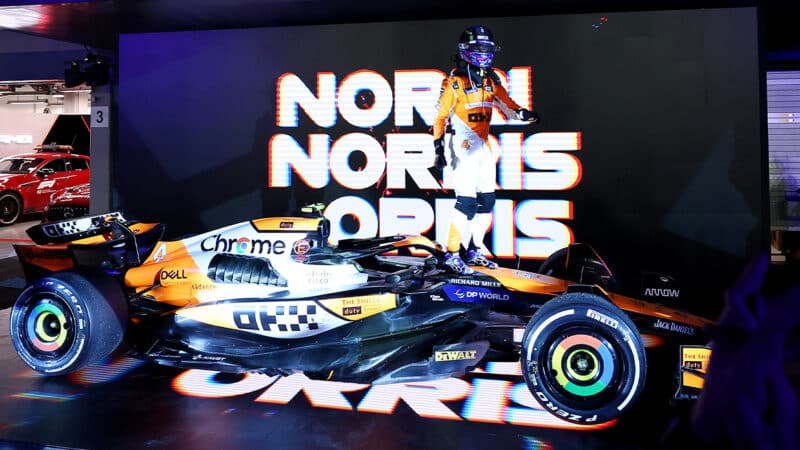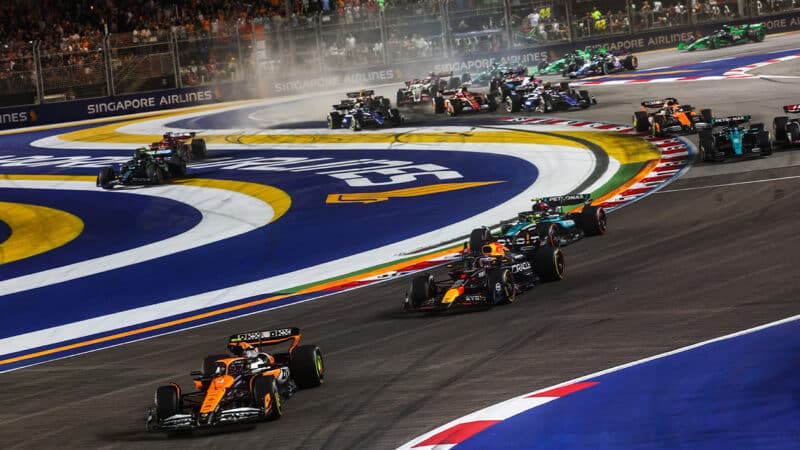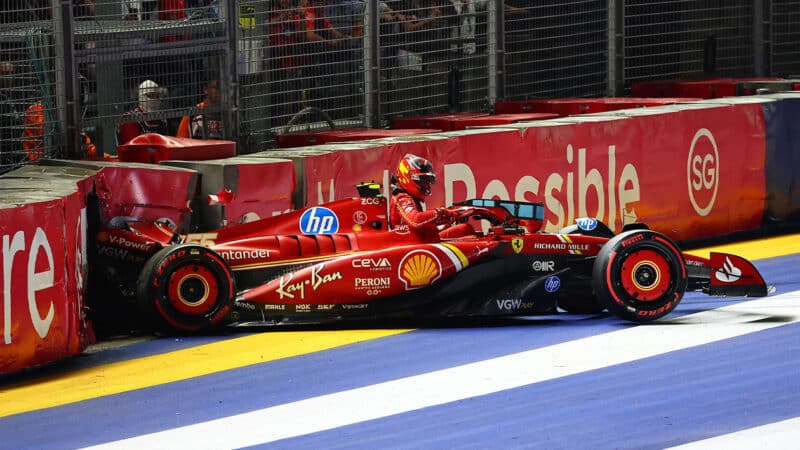Why Norris's F1 challengers didn't show up in Singapore
Nobody could challenge Lando Norris in his dominant 2024 Singapore Grand Prix win, but several drivers had the pace to do so. Mark Hughes examines why they couldn't get close to the lead McLaren

Lando Norris crossed the line more than 20sec ahead of second-placed Max Verstappen
Morgan Hancock/NurPhoto via Getty
Lando Norris performed the most dominant victory of the season beneath the Singapore floodlights.
On pole by 0.2sec from Max Verstappen’s Red Bull, he retained position off the line, got into the first corner ahead – and simply disappeared off into the night in his beautifully-balanced McLaren MCL38. With both on medium tyres in the first stint, he was at times around 1sec per lap faster than the Red Bull. His pace advantage on the hards in stint 2 wasn’t as great, but still he was able to build up a pitstop’s-worth of gap.
Balance on a high downforce set-up was what it was all about. That and Norris’s always formidable raw speed. He hit the ground running on Friday, totally at ease around the tricky confines. That great balance was another demonstration of the team’s understanding of aero elasticity, just expressed differently to the ‘mini DRS’ rear wing of the low-downforce tracks. In a field of cars which generally have a small window between low-speed understeer and high-speed oversteer, that balance is gold dust, not only giving its drivers a beautifully confidence-inspiring car in which to push but also allowing it to generate good front tyre temperatures without overheating the rears.

Norris led from pole. And drove away from the opposition
McLaren
Red Bull does not have the same aero elasticity, and its early-season balance has progressively been lost as more aero load has been chased. The nadir of that process was probably Monza. In the last couple of races a direction has been found to at least give Verstappen something he can work with. It looked awful on Friday, but that was as a result of going way too soft on set-up, having been spooked by last year’s car’s awful behaviour over the bumps and kerbs here. But on the smoother resurfaced track, it was capable of accepting a stiffer set-up – which it had for Saturday. Verstappen did a wonderful improvisation to put that car on the front row, but it was a far wilder ride than Norris’ pole.
Actually, on raw underlying pace Verstappen was not Norris’s potentially closest challenger here. That would have been his own team-mate Oscar Piastri and the Ferraris. But they all under-qualified.
Piastri
Had Oscar repeated his Q2 time he’d have started on the front row, even though he wasn’t as well attuned to the place as Norris. But he suffered a moment out of Turn 16. He just didn’t seem to have quite the same feel for how to use the tyres’ energy over the lap. A GPS overlay of his best lap on Norris’ shows he was actually faster in the first few corners but the lap time gradually bleeds away subsequently. It could be the Turn 16 moment on his Q3 lap was the consequence rather than the cause.
Anyway, it put him behind both Mercedes on the grid, cars which were potentially around 1sec per lap slower than the McLaren on the day. With his strategy skewed towards stopping late so as to maximise his tyre grip advantage over the Mercs, he was 40sec off the lead as he rejoined – and still had the Mercs to pass. He did so comfortably of course and even closed for a time on Verstappen. But with the front row start which might’ve been possible, who knows?
Ferrari
Charles Leclerc was flying through the Friday practices, trading blows with Norris. Carlos Sainz, troubled by a brake imbalance, wasn’t quite there but, pole-sitter of last year, he was expected to be right in the hunt on Saturday.

Sainz steps out of his cold-tyred Ferrari after qualifying crash
Grand Prix Photo
On the soft tyre though, the Ferrari was on the cusp of not being able to get the fronts up to temperature in time for the qualifying lap. A change in track grip into Saturday exposed that trait but it was exacerbated by Ferrari’s operations. There was some bluff and counter-bluff between the teams about who would leave the pitlane when; all of them trying to catch the track at its quickest. Leclerc appeared to make an early departure, encouraging the others to leave, but then both he and Carlos Sainz stopped in the dummy start part of the pitlane. This got the Ferraris out last, as they desired, but lost them a lot of tyre temperature in so doing. This in a car in which was prone to under-temperature fronts. It contributed to Sainz’s session-stopping accident and ensured that Leclerc had only one post-red flag lap – on which he ran outside of track limits and so had his time deleted. So a potentially Norris-challenging pair of cars started ninth and 10th, behind three much slower cars from Haas, RB and Aston Martin. By the time Leclerc had cleared those, the race was three-quarters of the way done. He got past the early-stopping Hamilton and chased the fourth place George Russell hard for the last few laps.
So with probably only the third-fastest car as his lead chaser, Norris delivered a totally dominant victory drive, albeit not without a couple of close shaves along the way, light wall contact which he got away with as he pushed on in the zone. It leaves him 52 points behind Verstappen with six races to go.
